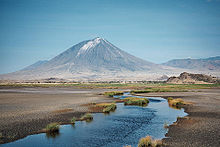Natronsee (Tanzania)
| Natron Lake | ||
|---|---|---|

|
||
| Geographical location | East Africa , Tanzania | |
| Tributaries | Ewaso Ngiro, Moinik, Peninj, Engare Sero and hot springs | |
| Drain | none | |
| Data | ||
| Coordinates | 2 ° 25 ′ 0 ″ S , 36 ° 0 ′ 0 ″ E | |
|
|
||
| Altitude above sea level | 600 m | |
| surface | 1040 km² | |
| Maximum depth | 2 m | |
|
particularities |
Soda lake |
|
Lake Natron is a lake in the eastern arm of the East African Rift . It is located together with the Magadi in Magadi Soda-pool (2 S °, 36 ° E), about 120 km southwest of Nairobi , between the Victoria and the Kilimandscharo .
About 20 km south of the lake is the Ol Doinyo Lengai , the only volcano on earth with low-melting lava, mainly consisting of sodium carbonate (soda), which is dissolved in large quantities in the lake.
The water level of the Natronsee is subject to considerable fluctuations; in the event of drought, the lake splits into a North Sea and a South Sea. Depending on the water level, the pH value fluctuates between pH 9 and pH 10.5.
geography
The lake is located in the eastern part of the East African Rift Valley ( Great Rift Valley ) at the foot of the Ol Doinyo Lengai volcano . It is located entirely in the state of Tanzania in the Maasai settlement area and is fed by the southern Uaso Nyiro and mineral-rich hot springs.
The extremely negative hydrological budget of the outflow-free lake is not offset by the rainfall in the 23,207 km² catchment area. This and the unusually basic igneous rocks in the area cause strong salinity and alkalinity of the water. The lake is one of the most famous soda lakes .
It is intended to build a soda factory there.
Flora and fauna
The lake is home to a remarkable variety of birds , including a large population of Lesser Flamingos of up to 2.5 million individuals. All four species of cichlids from the genus Alcolapia ( A. alcalica , A. grahami , A. latilabris and A. ndalalani ) live in the lake . The reddish color of the lake, which can partly be seen from space, is caused by billions of brine shrimp ( Artemia salina etc.), which are only a few millimeters in size and are the main food of the flamingos.
Preserving effect of the salts
The British nature photographer Nick Brandt found well-preserved animal carcasses of birds and bats that were washed ashore while searching for a subject at Lake Natron . The high proportion of sodium carbonate and other salts in the water led to calcification on the animals' bodies, which prevented further decay.
In film and television
The lake is main setting of the documentary film produced by Disney Mystery of the Flamingos , in which the life of the local dwarf flamingos is shown.
Historical
Since 2008, around 120,000 year old fossil footprints of modern humans have been analyzed, which were impressed on the then edge of the lake in fresh volcanic ash. A total of 350 prints on 150 square meters have been detected, which come from more than 30 individuals (men, women and children) who were probably traveling in two groups.
Web links
- LakeNet information about Lake Natron
- The world : waters in Tanzania. Lake Natron turns birds into pillars of salt. (accessed on October 8, 2013.)
- Streaming Planet: a video about Lake Natron and its flamingos
Individual evidence
- ↑ Rowan Hooper: Deadly lake turns animals into statues. New Scientist , October 1, 2013, accessed October 2, 2013 .
- ↑ Archived copy ( Memento from September 24, 2015 in the Internet Archive )
- ↑ http://www.berliner-zeitung.de/reise/-in-tansania-bizarre-tierkadaver-am-natronsee,10808656,24575976.html Bizarre animal carcasses at Lake Natron
- ^ Ann Gibbons: Ancient Footprints Tell Tales of Travel. In: Science , Volume 332, No. 6029, pp. 534-535, doi: 10.1126 / science.332.6029.534-b


